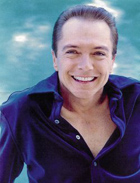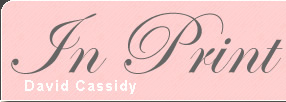
I Think I Love You: Life, Death, and the Enduring Legacy of David Cassidy Fever
December 14, 2017
By Haley Gienow-McConnell
https://nursingclio.org
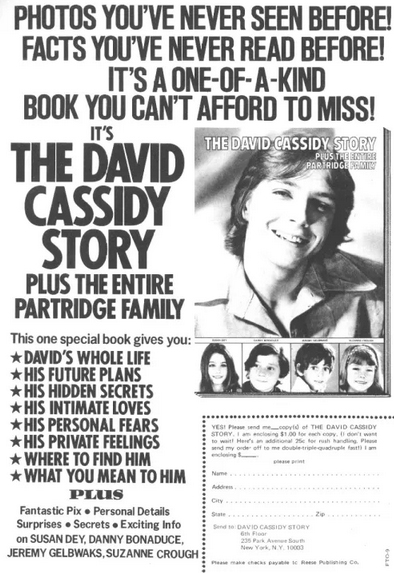
On May 30, 1974, 14-year-old Bernadette Whelan died after lingering in a coma for four days. The cause of her death? Officially, “traumatic asphyxiation.” Unofficially, according to the coroner, “a victim of contrived hysteria,” otherwise known as David Cassidy Fever.
Twenty-six years later, at 14 years of age, my own life was saved. The cause of my salvation? Officially, recovering from anorexia nervosa. Unofficially, David Cassidy Fever. It was the year 2000, and for this gal, Cassidy Fever was still virulent, some 30 years after its first strains were detected, following The Partridge Family’s premiere on ABC in the fall of 1970. David Cassidy became a household name for his mesmerizing portrayal of the handsome eldest son, Keith Partridge. Centered on the misadventures of a musical family, The Partridge Family also launched Cassidy’s music career.
Though I view pop music with a peculiar reverence, I know many who do not. Thus, it behooves me to tell you that Cassidy never intended to be a pop idol. In fact, he set out to be a serious actor when he entered show business. 1 But it is for his musical career, and his turn as a pop idol, that Cassidy is best remembered. You might even say that was by his music that Whelan and I lived and died.
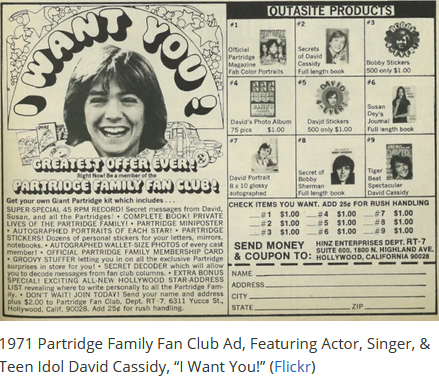
I have always felt a profound connection to Whelan, the young Brit whose life was tragically cut short after being crushed by a surge of frenzied fans at a Cassidy concert at London’s White City Stadium. The same age at which Whelan’s story came to a tragic end, my story mercifully continued, in part, thanks to my burgeoning affection for Cassidy. As all tweens and teens know, adoring your idol can indeed feel like a kind of fever, even a matter of life and death.
What connects Whelan and I is that our adoration of Cassidy was literally that. At the age of 12, I had begun flirting with an eating disorder, which by the age of 13 had devolved into full-blown anorexia nervosa. By 14, I was so ill and consumed by the disease that I felt poised on the precipice between life and death. Nothing mattered to me as much as my disease, and nothing commanded my attention as much as starving myself. That is, until I discovered David Cassidy.
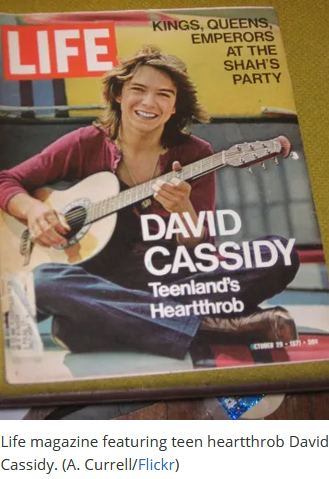
For reasons that remain elusive to me, I became turned on to Cassidy at a time when most of my peers’ affections were directed at the heartthrobs du jour, namely members of the Backstreet Boys, NSync, or members of some now-forgotten male pop-rock ensemble. O-Town, anyone?
In Cassidy I found an outlet to redirect my previous preoccupation with food, and he proved to be a worthy investment of my time. I was surprised to find in Cassidy a level of gravitas that resonated with me. His personal struggles ran the gamut from substance abuse to financial dilemmas to failed marriages and everything in between. The irony of Cassidy being irked that his identity was once conflated with Keith Partridge’s is that, in retrospect, Cassidy probably would have relished living a life as charmed as Keith’s. 2
In his imperfections, and subsequent resilience, I found considerable peace and comfort. When I discovered Cassidy in the early 2000s, he was experiencing something of a personal and professional high. For Cassidy, the early 90s saw a new marriage to singer-songwriter Sue Shifrin, and a new son, Beau. Shifrin’s talent for songwriting, and her unflappable faith in Cassidy, also inspired something of a career renaissance for Cassidy. A couple of new adult-contemporary hits, as well as critically and commercially acclaimed turns on Broadway and the Vegas stage, rounded out the rest of decade for Cassidy, resulting in “what was arguably the most fertile, creative time of [his] life.” 3
As a young girl going through the worst period in my life so far, seeing the arc of Cassidy’s narrative from international superstar to fallen idol to personally and professionally-fulfilled entertainer was significant for me. If my idol could know intimately the depths of despair and come back stronger than ever, maybe I could too. It was with Cassidy posters adorning my wall, and his 1972 album Cherish on my stereo that I began my slow but steady climb from the abyss of anorexia back to health.
Let me be perfectly clear: I am well aware that pop-rock idols do not cure eating disorders. Nor do they liberate oppressed people, eliminate the national debt, or even necessarily create great art. Whatever their caliber, pop-rock idols do entertain us and bring us joy, and that is considerable. To quote an episode of the Partridge Family, in which Keith Partridge’s girlfriend questions the validity of pop music, “Nothing needs less justification than making others happy.”4
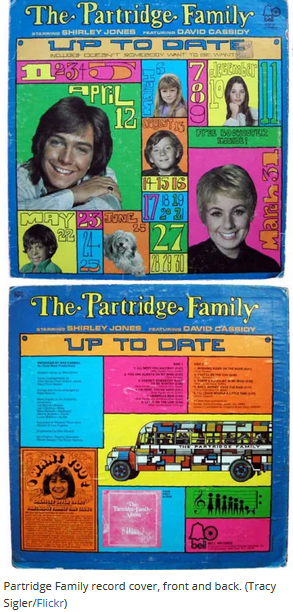
And through that joy, pop idols provide a safe outlet for fans, many of them very young, to channel and explore a range of other feelings, such as love, longing, desperation, hope, frustration, passion, self-consciousness, loyalty, mania, maturation, and a host of other feelings for which there are no labels. Pop idols afford a sense of belonging for like-minded fans, in Cassidy’s case millions of them. At one time his fan club boasted more fans than Elvis Presley’s and the Beatles’ combined.5
Idols also offer a sense of identity, as in cases where fan loyalties diverge. In the early 1970s, you were either a David Cassidy supporter, or a champion of Donny Osmond. My mother was the latter, and she was perplexed when years later I became the former.
Today, I am grown woman whose passion for Cassidy has been replaced by my passion for my work as a historian and disability rights advocate and ally. And the solace I once found in Cassidy’s music I now find in my husband and young daughter. I am pleased to report that in the 17 years since fate intervened in the form of a green-eyed, shag-haired guardian angel, I have been free from anorexia. In short, my need for David Cassidy has waned substantially.
I wish I could say that the happy circumstances in which Cassidy found himself when I discovered him back in the early 2000s continued. Sadly, the final act of Cassidy’s life was difficult. As if dire financial straits, the dissolution of his marriage, the loss of his mother, and struggles with substance abuse weren’t enough, in February 2017, Cassidy disclosed to the public that he was living with dementia. And on November 21, 2017, he passed away.
As someone who long admired Cassidy, my fear is that his legacy will be reduced to that of merely Keith Partridge, a troubled idol. To me, to countless fans, and to his friends and family, he was so much more. It’s true, I may not need David Cassidy as I once did. But now that he has passed, and can no longer speak for himself, I feel he needs a new spokesperson. As a cultural historian and long-time Cassidy fan, I’m appointing myself as the official David Cassidy docent.
He needs me to restore the impressive part of the Cassidy narrative that ought to be celebrated, to remind people that in 1970 his pop smash, “I Think I Love You,” actually outsold The Beatles “Let It Be.”6 At the same time he was outselling The Beatles, he was also befriending them. Cassidy and John Lennon were social on numerous occasions.7
You’d be far more likely to catch Cassidy breaking bread with a former Beatle than with Bobby Sherman. Cassidy may have been known as a darling of the pop scene, but his personal musical affinities tended towards rock and blues. If you had the pleasure of watching Cassidy perform achingly vulnerable and fresh interpretations of Beatles and B.B. King hits live as I did, you’d know this. One of the great ironies of the coverage of Cassidy’s career since his passing has been the attempt to undermine it with a jaded analysis of the pop-industrial-complex. There is no denying that said complex undermined Cassidy’s artistic talent, which was considerably greater than the material he was offered as a Partridge and after. The irony resides in the fact that this story is decades old — almost as old as Cassidy’s career itself — and Cassidy was the first to tell it.
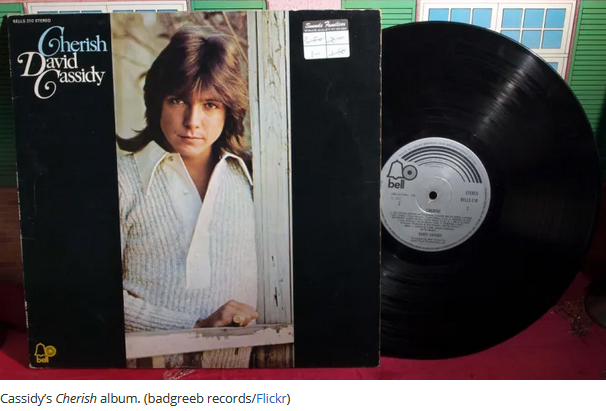
In an effort to abandon the pop persona foisted upon him, Cassidy gave an interview to Rolling Stone’s Robin Green for the May 11, 1972 cover story. In that story, Cassidy exposed the fallacies of the business which made a star, and disclosed titillating details about his personal life. Accompanying that story were the now legendary nude photos of Cassidy shot by Annie Leibowitz, much to the shock of young Cassidy fans, and even more to the ire of their parents. Cassidy spent a lifetime trying to correct shallow impressions of him, impressions that formed early in his career, and which apparently outlived him, as the rather reductive post-mortem tributes to Cassidy are a testament.
I’m not claiming David Cassidy was an artist and entertainer the caliber of, say, Prince. And though he may have turned out to be my guardian angel, neither was he a saint. He had personal demons and shortcomings, and he’d be the first to admit that. Do I think David Cassidy ought to be lionized as one of the great figures in our cultural pantheon? I’m just objective enough to say no. But do I think he deserves more than the headline “Former Teen Idol Dies at 67”? I do.
He led a fascinating life, made an indelible impression on the pop world, and mattered to people. A whole lot of people. And their numbers are no less because most of his admirers discovered him when they were very young. The significance of their adulation should not be discounted because most of his admirers were female. Perhaps the greatest crime in being dismissive of teen idols is not that it diminishes the idols themselves, but that it diminishes the audiences who idolize them.
I didn’t know David Cassidy personally, though I did have the pleasure of meeting him on several occasions. The first time I met him was thanks to a letter I gave to his tour manager before a concert I attended in 2002. In the letter, I expressed my admiration and gratitude for the effect Cassidy had on my life and the lives of countless others. After reading the letter, Cassidy invited me to meet him after the show. He proved to be every bit the kind, gracious, and charismatic man I’d always imagined him to be. I will be forever grateful for the positive influence he had on my life. When you hear the name “David Cassidy,” I won’t fault you if Keith Partridge is the first thing that comes to mind. But please, I beseech you, don’t let it be the last.
Notes
1. Prior to The Partridge Family, Cassidy was on Broadway and featured in a number of dramatic television roles on series such as Ironside, Marcus Welby M.D., Bonanza, The Mod Squad, and Medical Center. Following the Partridge Family, he did a guest spot on Police Story, which earned him an Emmy nomination, and the opportunity to launch his own spin-off series, David Cassidy: Man Undercover. As cited in David Cassidy, C’mon Get Happy: Fear and Loathing on the Partridge Family Bus (New York: Warner Books, 1994), 44-46, 218-219.
2. David Cassidy, C’mon Get Happy: Fear and Loathing on the Partridge Family Bus (New York: Warner Books, 1994), 81.
3. David Cassidy, Could It Be Forever?: My Story (London: Headline Publishing Group: 2007), 325-332.
4. The Partridge Family, “Beethoven, Brahms, and Partridge,” directed by Charles Rondeau, aired September 29, 1973 (Sony Pictures Home Entertainment, 2009), DVD.
5. DavidCassidy.com, “Fans,” (accessed November 19, 2017).
6. David Cassidy, C’mon Get Happy: Fear and Loathing on the Partridge Family Bus (New York: Warner Books, 1994), 92.
7. David Cassidy, C’mon Get Happy: Fear and Loathing on the Partridge Family Bus (New York: Warner Books, 1994), 93.
